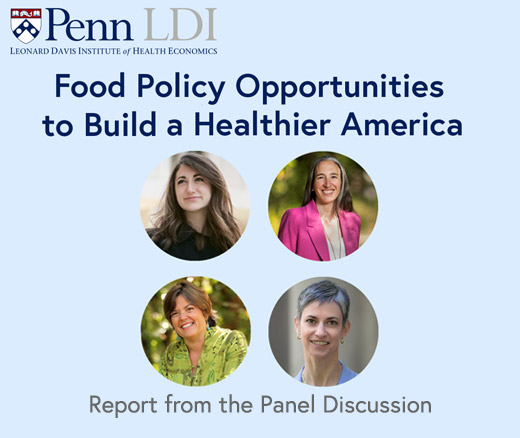
Contradictions That Confuse Federal Food Policies
Announcing Bold New Goals While Crippling the Infrastructure Needed to Achieve Them
Population Health
Brief

Background: The U.S. Department of Agriculture (USDA) Supplemental Nutrition Assistance Program (SNAP) is the nation’s largest federal nutrition assistance program, providing monthly benefits for food to more than 42 million low-income people.1 SNAP has been proven to lift families from poverty and reduce food insecurity–inconsistent access to an adequate, nutritious diet.2 The COVID-19 pandemic brought U.S. food insecurity to its highest levels in recent history,3 prompting Congress to pass legislation allowing temporary issuance of additional SNAP benefits, called Emergency Allotments, to SNAP recipients. Emergency Allotments increased SNAP benefits substantially, adding an average of $126 to the monthly benefit in the first year and $166 in subsequent years.4 Emergency Allotments ended in March 2023, but 18 states ended them early, when their state public health emergency expired.
Richterman and colleagues used national data from the U.S. Census Bureau’s Household Pulse Survey to study the effect of ending Emergency Allotments on food insufficiency–a severe form of food insecurity.5 Data from more than 3 million survey respondents showed that food insufficiency increased significantly after the expiration of Emergency Allotments and persisted over 15 months. Specifically, after Emergency Allotments ended:

When these results are applied to the entire U.S., they imply that approximately 2 million additional Americans experienced food insufficiency as a result of Emergency Allotments ending.
These findings add to research showing the standard SNAP benefits are insufficient to afford an adequate diet.6 Prior to the COVID-19 pandemic, 30% of households receiving SNAP were food insecure and many families struggled when benefits ran out at the end of the month.7 The 2018 Farm Bill–omnibus legislation governing federal nutrition programs, including SNAP–directed the USDA to revise the Thrifty Food Plan, which forms the basis for the SNAP benefit amount, by 2022 and every five years thereafter. Revisions to the Thrifty Food Plan resulted in a 27% increase in the average SNAP benefit beginning in October 2021.6 However, this new research shows that revisions made so far have been insufficient for ensuring food security for all Americans.
The USDA is statutorily required to revise the Thrifty Food Plan every five years to reflect the latest research. The 2023 Farm Bill should, at a minimum, uphold this requirement. Ideally, Congress should replace the Thrifty Food Plan with a more adequate food plan. The Low-Cost Food Plan better represents what low- and middle-income households require for food and may help recipients of SNAP afford an adequate and nutritious diet.8,9
1. Food and Nutrition Service U.S. Department of Agriculture. (2023). SNAP: Monthly Participation, Households, Benefits. https://fns-prod.azureedge.us/sites/default/files/resource-files/snap-4fymonthly-7.pdf
2. Gunderson, C. (2022). SNAP: The Most Important Component of Our Efforts to End Food Insecurity in the United States. American Journal of Public Health, 112 (10), 1370-1371. https://ajph.aphapublications.org/doi/full/10.2105/AJPH.2022.307058
3. Centers for Disease Control and Prevention. (2023). Food Insecurity Trajectories in the US During the First Year of the COVID-19 Pandemic.https://www.cdc.gov/pcd/issues/2023/22_0212.htm#:~:text=In%20the%20early%20stages%20of,%2D2020%20(Figure%201)
4. Institute for Policy Research, Northwestern University. (2023). The Impact of SNAP Emergency Allotment on SNAP Benefits and Food Insufficiency. https://www.ipr.northwestern.edu/documents/reports/ipr-rapid-research-report-snap-emergency-allotments-impact-27-january-2023.pdf
5. Richterman, A., Roberto, C.A., & Thirumurthy, H. (2023). Associations Between Ending Supplemental Nutrition Assistance Program Emergency Allotments and Food Insufficiency. JAMA Health Forum, 4(8). https://jamanetwork.com/journals/jama-health-forum/fullarticle/2808293
6. Center on Budget and Policy Priorities. (2021). More Adequate SNAP Benefits Would Help Millions of Participants Better Afford Food. https://www.cbpp.org/research/food-assistance/more-adequate-snap-benefits-would-help-millions-of-participants-better
7. Brady, P.J., Harnack, L., Widome, R., Berry, K.M., & Valluri, S. (2023). Food Security Among SNAP Participants 2019-2021: A Cross-Sectional Analysis of Current Population Survey Food Security Supplement Data. Journal of Nutritional Science. 12. https://doi.org/10.1017/jns.2023.32
8. Food Research and Action Center. (2012). Replacing the Thrifty Food Plan in Order to Provide Adequate Allotments for SNAP Beneficiaries. https://frac.org/wp-content/uploads/thrifty_food_plan_2012.pdf 9. Food and Nutrition Service U.S. Department of Agriculture. (2021). Thrifty Food Plan, 2021. https://www.fns.usda.gov/CNPP/thrifty-food-plan-2021

Announcing Bold New Goals While Crippling the Infrastructure Needed to Achieve Them

Promising New Evidence and What’s Next

From 1990 to 2019, Black Life Expectancy Rose Most in Major Metros and the Northeast—but Gains Stalled or Reversed in Rural Areas and the Midwest, Especially for Younger Adults

A Penn LDI Seminar Focuses on Why They’re Important for the Future

Former Philadelphia Health Commissioner Warns That Gutting the CDC, Undermining Vaccines, and Politicizing Science Will Leave the U.S. Dangerously Unprepared for the Next Pandemic

Rural Parents Had More Emergency Visits and Insurance Loss Than Urban Peers, an LDI Study Shows. Integrated Baby Visits Could Help All Parents Be Healthier